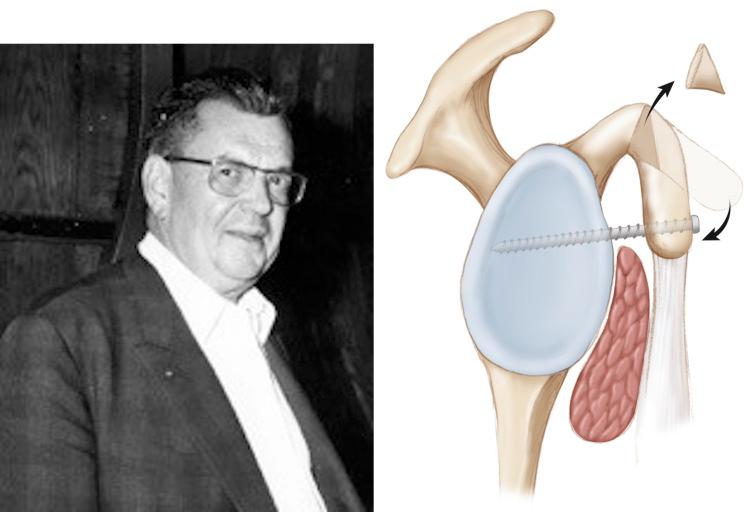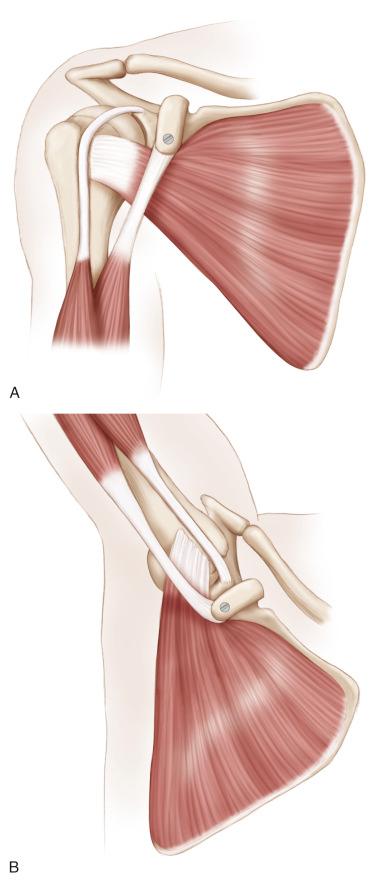Physical Address
304 North Cardinal St.
Dorchester Center, MA 02124
Recurrent anterior shoulder instability in patients over 40 years old presents a difficult therapeutic problem when it is associated with an irreparable rotator cuff tear. This type of anterior instability, which is mainly secondary to the loss of the posterior check rein, was initially described by McLaughlin and was described by Craig as “instability from the posterior mechanism” whereby the intact anterior labrum and capsule act as a hinge while the humeral head rolls over the anterior glenoid rim. The Trillat procedure stabilizes the shoulder by placing the conjoint tendon closer to the glenohumeral joint and lowering the subscapularis, using the same dynamic “sling effect” as the Latarjet procedure. Furthermore, the arthroscopic technique is easier (i.e., no need to pass the bone block through the subscapularis muscle) and safer (i.e., no pectoralis minor detachment) than the Latarjet procedure.
The Trillat procedure consists of performing a closed-wedge osteotomy of the coracoid, which is tilted downward, posteriorly, and medially and then fixed to the glenoid neck with a nail or screw implanted above the subscapularis. The procedure stabilizes the shoulder by placing the conjoint tendon closer to the glenohumeral joint and lowering the subscapularis using the same dynamic “sling effect” (or “seat belt effect”) as the Latarjet procedure.
Typically, the patient is over 40 years of age.
The patient’s chief complaint is of traumatic, recurrent anterior shoulder instability.
There may be a history of previous failure of shoulder stabilization or cuff repair.
There is a massive irreparable cuff tear that is not symptomatic (no pain and no loss of active elevation).
There is no glenohumeral arthritis.
Significant atrophy of the supraspinatus and/or infraspinatus may be visible.
Patient must have maintained normal active forward elevation and rotation.
A nonfunctional shoulder is a contraindication for this procedure.
Patients may display apprehension when the shoulder is positioned in abduction–external rotation.
A loss of active or passive forward elevation or rotation and a painful shoulder are contraindications for the Trillat procedure.
A hyperlaxity of the shoulder (i.e., external rotation over 85 degrees) is a good indication if there is no bone loss, especially in young patients.
Tendon retraction is to the level of the glenoid or beyond (stage 3 or 4).
Severe fatty infiltration of the cuff muscles (Goutallier stage 3 or 4).
Proximal migration of the humeral head under the acromial arch (acromiohumeral distance, <7 mm) on an anteroposterior radiograph with the arm in neutral rotation.
Bankart repair alone is insufficient owing to the absence of the posterior check rein provided by the posterior rotator cuff.
Rotator cuff repair is not feasible, owing to retraction, fatty infiltration, or presence of proximal migration of the humerus.
Hill-Sachs remplissage is not possible, owing to tendon retraction and absence of a Hill-Sachs lesion (or in case of a small Hill-Sachs lesion).
Latarjet is possible; however, transferring the coracoid through the intact subscapularis muscle carries the risk of affecting the already fragile shoulder muscle balance and losing active elevation.
A free iliac crest bone graft, according to Eden-Hybinette, carries the same risk and may additionally worsen degenerative changes of the glenohumeral joint.
Reverse shoulder arthroplasty is relatively contraindicated in this subgroup of patients because of age, maintained forward elevation, and frequent absence of shoulder pain.
A mild osteoarthritis (Hamada and Fukuda grade 1 or 2) is not a contraindication for this procedure, but if it is severe (Hamada grade 3 or more) or associated with pain, it becomes a contraindication, and then a reverse shoulder arthroplasty appears to be the best option.
See Figs. 35.1 and 35.2 .


The conjoint tendon is placed closer to the glenohumeral joint, lowering the subscapularis, using the same dynamic “sling effect” as the Latarjet procedure.
It is important to recognize the proximity of neurological structures while preparing the coracoid.
Always keep in mind that the axillary nerve and the musculocutaneous nerve are at the medial border of the conjoint tendon between 1.5 and 3 cm under the tip of the coracoid.
Recurrent, traumatic anterior shoulder instability secondary to massive irreparable posterior rotator cuff rupture.
Recurrent anterior shoulder instability secondary to hyperlaxity has also been a described indication.
The patient is positioned in a beach chair position without traction.
The arm is placed in a movable support (SPIDER Limb Positioner; Smith & Nephew, Andover, MA, USA).
Become a Clinical Tree membership for Full access and enjoy Unlimited articles
If you are a member. Log in here